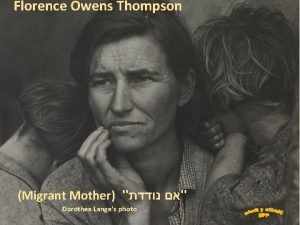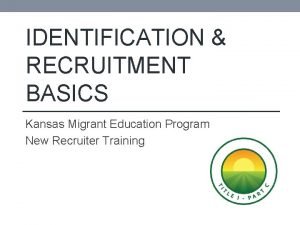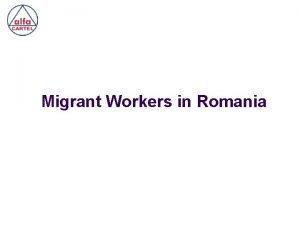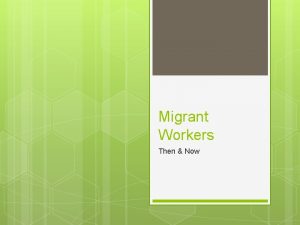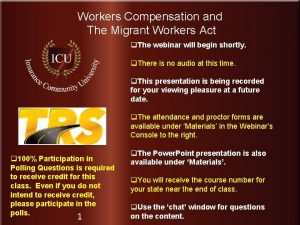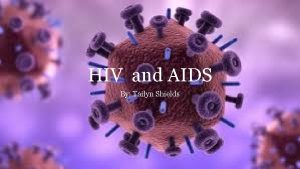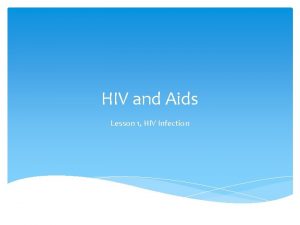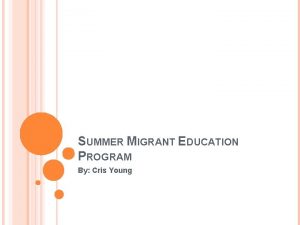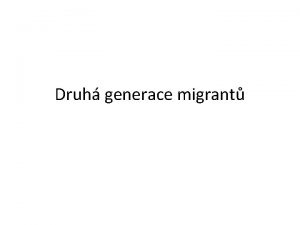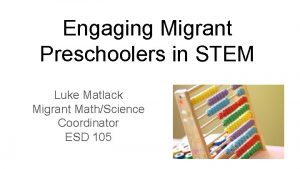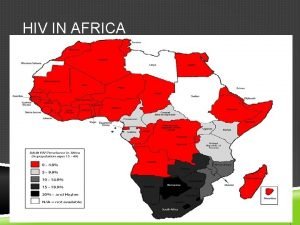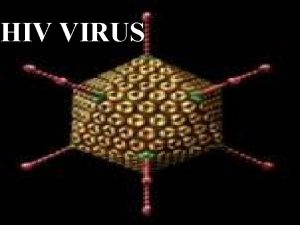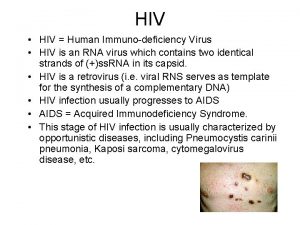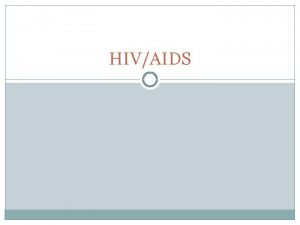SEXUAL NETWORKING AND HIV RISK IN MIGRANT WORKERS
























- Slides: 24

SEXUAL NETWORKING AND HIV RISK IN MIGRANT WORKERS IN INDIA TIME TO SHIFT THE PARADIGM? Lawrence Gelmon MD MPH DTM&H Univ. Manitoba / Univ. Nairobi INDIA CANADA HIV/AIDS PROJECT (ICHAP) UNIVERSITY OF MANITOBA Rajasthan AIDS Control Society (RSACS) Karnataka Soc. for AIDS Prevention (KSAPS) Supported by CIDA

The Hamara Project • An HIV/AIDS prevention and care project working with informal sector rural migrants from the Shekawati region of Rajasthan • Provides coverage from place of origin, in transit, and in select destination places • Hamara Project overall Objectives: – To understand HIV-related vulnerability – To develop programme models


MOBILITY AND MIGRATION Common wisdom • Migrant populations have higher levels of HIV infection than those who do not move – independent of the HIV prevalence at the site of departure or the site of destination • Migrant workers often encounter language and other difficulties, resulting in feelings of “discontinuity and transition” that enhance loneliness and/or sexual risk-taking.

MOBILITY AND MIGRATION Common wisdom 2 • A lack of HIV/AIDS awareness, information and social support networks at both transit and destination points cumulatively contribute to a migrant's vulnerability. • Spouses of migrants are also HIV-vulnerable as their husbands return home on a regular basis.

MOBILITY AND MIGRATION 2 • A lack of information on: – families of migrants left behind – sexual relationships of migrants and their wives when separated • Historically HIV/AIDS programs have not targeted or reached rural migrants though by definition they constitute a likely sex client group (men with disposable income away from home)

MOBILITY AND MIGRATION 3 • Objectives of these studies were to contribute to understanding about the level of risk among rural migrants and their families, and the ways in which migration is fuelling the spread of HIV in rural India

Definitions • Migrants – someone who had gone out of the village for work for more than 6 months during the last 2 years. No longer a migrant if home >2 yrs. • Potential migrants – planning to move for work in the next 6 months • Spouses of migrants • Spouses of potential migrants

Biological baseline study • February - March 2004, 15/133 villages • Household census - all households • Health camp – HIV /STI tests, counselling and treatment

Biological baseline study findings – household survey • 14 -30% of the population migrate for work – one-third of the total male population surveyed and less than 3% of the females. • 90% travelled in India, of whom 80% went to one of: Jaipur, Maharashtra/Mumbai, Haryana/Delhi, Gujarat, Punjab

Biological baseline study findings – health camp • Average HIV+ seroprevalence of 1% in four groups – 4 x the state average – But methodological problems made the results suspect • High rate of reported RTIs in men and women – 70 -90% confirmed medically

Health Camp Results 4: Sexual behaviour questionnaire • Significant rates of reported premarital /extramarital sex, visiting sex worker • A few spouses of migrants acknowledged receiving payment for sex • But a small sample size led to a more detailed sexual networking study being undertaken.

Sexual networking study Objectives • To study the sexual behavior of the migrant spouses, potential migrants, returned migrants, visiting migrants, adolescents, sex workers and MSMs in the village settings and how are they sexually linked with each other • To identify the villages, which are at higher risk and need more intensified outreach services and attention in the NACP - III.

Sexual networking study Methods • All 133 villages in three districts of Shekhawati region of Rajasthan – Churu, Sikar, Jhunjhunu • Primary stakeholders: migrant spouses, potential migrants, returned migrants, visiting migrants, sex workers, MSM • Secondary stakeholders: condom depot holders, village health committees, peer educators, anganwadi workers

Sexual networking study Methods 2 • Key informant interviews: – 211 primary stakeholders, 582 secondary • Focus group discussions: – 318 primary stakeholders • “Polling booth” questionnaires: – 3, 166 primary stakeholders • The same set of questions related to perceptions of sexual activities amongst the villagers and migrants.

Sexual networking study Results 1 – Sample questions • Married men in this village have lovers other than their wives • Know women who have lovers other than their husbands • Visiting migrants remains faithful to their wives for sex • Know women in the village who are sex workers • Unmarried visiting migrant workers have sex in the village during their visit • Know men in village who visit sex worker in the village or outside • Men from other villages visit sex workers in the village • Migrant workers visit sex workers in the visiting village • Migrant workers have sex with men in the visiting village • You know men who have sex with men in your home village

Sexual networking study Results 2 – Sample answers (% positive) • Know women who have lovers other than their husband: 48 -62. 7 (f. spouses) • Unmarried girls in the village have lovers (40 -63) and sometimes get pregnant: 33. 1– 42 (f. spouses) • Know women/ men who have sex within the extended family: 35. 1 – 48. 2 (f. spouses); 20. 4 – 25. 7 (males) • Your husband has lovers other than you in the village: 10 -30 (f. spouses) • Married men have lovers other than their wives: 38. 8 - 54 (men) • There are women in the village who sell sex / know women in the village who are csws: 40 -65 (all groups)

Sexual networking study Results 3 – Sample answers (% positive) • Migrant workers have extramarital affairs in the visiting village / visit sex workers in the visiting village: 40 - 58 (all men) • Know men who visit sex workers in the village: 20 – 40 (all men) • Migrant workers have sex with men in the visiting village: 4. 2 - 14. 5 (all men) • The answers by the secondary stakeholders estimated even higher rates than those reported above.

Sexual networking study Results 4 • Migrants return home anywhere from once a month to once every ten months. When they return home 10 -20% have sex with other women other than their wives in their home village. • Knowledge of condoms (38 -70%) • Knowing about symptoms of STIs and the need for treatment (28 -55%).

Sexual networking study Results 5 – married men • How do you fulfill your sexual desires when away from your wife? ” – 15 -20% masturbated – 20 -30% “controlled themselves” – 8 -20% had sex with other women, including sex workers. • How do other married men fulfill their sexual desires? – 70% had sex with other women, including sex workers – 10% controlled themselves – Only 5 -7% thought that anyone else masturbated

Summary of results and conclusions 1 • Migrant workers and their spouses are at increased risk of acquiring HIV and STIs, not only through the act of migrating, but also because of the inherent high rate of unprotected sexual networking in their home communities. • Sexual networking in the home community is replicated when the migrants travel elsewhere. • Migration does intensifies risk, BUT…….

Summary of results and conclusions 2 • The risk for migrant workers is not that they will change their sexual behavior when they travel, but rather that they will be taking their established sexual behavior into an environment where there is a higher rate of HIV/STIs, with a higher risk of contracting HIV/STIs and bringing them home to their sexually-active spouses. • This is different from the commonly-accepted wisdom, that the act of being a migrant causes someone to assume high-risk behaviour.

Summary of results and conclusions 3 Therefore, because of these intersecting risks, migration programming has to address the point of origin as well as the point of destination.

Thanks to: • Co-authors: Karuna Singh, Parinita Bhattacharjee, Priyamvada Singh, Aine Costigan, Stephen Moses, James Blanchard. • University of Manitoba, India-Canada HIV/AIDS Project (ICHAP) • Rajasthan State AIDS Control Society (RSACS) • Canadian International Development Agency • Acknowledgements and thanks to ICHAP teams and communities in Rajasthan and Karnataka
 Proper adjective for steinbeck
Proper adjective for steinbeck Sdn vs traditional network
Sdn vs traditional network Market risk credit risk operational risk
Market risk credit risk operational risk Hiv risk factors
Hiv risk factors Staar test directions
Staar test directions Troy owens migrant mother
Troy owens migrant mother Migrant mother analysis essay
Migrant mother analysis essay Pepsinogène
Pepsinogène Peter skrzynecki biography
Peter skrzynecki biography Péristaltisme
Péristaltisme Reverse hierarchical diffusion
Reverse hierarchical diffusion Environmental perception definition ap human geography
Environmental perception definition ap human geography Kansas migrant education program
Kansas migrant education program Migrant info point
Migrant info point Washington state migrant council
Washington state migrant council Internal migration ap human geography definition
Internal migration ap human geography definition Residual risk and secondary risk pmp
Residual risk and secondary risk pmp Business risk and financial risk leverage
Business risk and financial risk leverage Relative risk
Relative risk Attributable risk (ar)
Attributable risk (ar) Chapter 25 sexually transmitted infections and hiv/aids
Chapter 25 sexually transmitted infections and hiv/aids Chapter 24 sexually transmitted diseases and hiv/aids
Chapter 24 sexually transmitted diseases and hiv/aids Risk projection
Risk projection Risk management avoidance
Risk management avoidance Absolute risk vs relative risk
Absolute risk vs relative risk





